Filamentous algae, often referred to as “pond scum,” “string algae,” or “floating pond algae,” are common nuisances in ponds and lakes. These algae form dense, hair-like mats that can cover the water’s surface, disrupting the ecosystem and aesthetics of aquatic environments. Understanding filamentous algae is crucial for effective management and control.

Filamentous algae are a type of green algaecomposed of long chains of cells that intertwine to form visible threads or filaments. These filaments can attach to submerged surfaces or float freely, creating thick mats on the water’s surface. Common genera include Spirogyra, Cladophora, and Pithophora.
Filamentous algae appear as green, slimy, hair-like strands that can form extensive mats. These mats often float on the water’s surface, especially during warm, sunny days when oxygen produced during photosynthesis becomes trapped, causing the algae to rise. The texture can range from soft and cottony to coarse and gritty, depending on the species.
Before spotting the signs, it’s important to understand why oxygen levels might drop in the first place. Here are some of the most common culprits:
Organic matter build-up, such as decaying leaves or waste
Several factors contribute to the proliferation of filamentous algae:

While filamentous algae are a natural part of aquatic ecosystems, excessive growth can lead to:

Manually removing algaeusing rakes or nets can be effective for small ponds. However, this method is labor-intensive and may not prevent regrowth if underlying nutrient issues aren’t addressed.
Introducing algae-eating fish, such as grass carp, can help control algae populations. However, this method requires careful consideration of the pond’s ecosystem and local regulations.
Algaecides can be used to control filamentous algae. Products containing copper compounds are commonly used, but they must be applied carefully to avoid harming fish and beneficial plants. Always follow label instructions and consider consulting professionals before application.
Reducing nutrient inputs is crucial for long-term control. Implementing buffer zones with vegetationaround the pond can help filter runoff. Limiting fertilizer use near water bodies and ensuring proper septic system maintenance are also effective strategies.
Managing filamentous algae can be challenging, but professional assistance can make a significant difference. Pond Guru offers comprehensive algae control services tailored to your pond’s specific needs. Our team conducts thorough assessments and implements sustainable solutions to restore and maintain the health of your aquatic environment.
Dealing with duckweed in a pond is not a one-time event. If you’re struggling with repeated outbreaks or want a professional, eco-friendly solution, contact Pond Guru. We offer expert site visits, personalized pond treatment plans, and long-term duckweed control strategies.
Pond scum refers to the thick mats of filamentous algae that accumulate on the surface of ponds, giving a green, slimy appearance.
While small amounts are harmless, excessive filamentous algae can deplete oxygen levels, leading to fish stress or death.
Yes, but it's essential to choose fish-safe products and apply them according to the manufacturer's guidelines.
Managing nutrient inputs, ensuring proper aeration, and maintaining a balanced ecosystem are key preventive measures.
Pond Guru provides algae control services, including assessments, treatment plans, and ongoing maintenance to ensure a healthy pond environment.